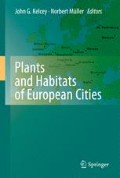Abstract
This book covers a wide range of well-known European cities extending from Almería in the south-west to St. Petersburg in the north-east and from Sofia in the south-east to London in the north-west with most cities being concentrated in central Europe, see Fig. 1. There are five major gaps in the geographical representation, Scandinavia, eastern Europe (Moscow to the Urals), Balkan Peninsula, southern Europe and the Iberian Peninsula (including France) – Almería being the single exception to the last two. In terms of population size, London was the world’s first mega-city (more than one million people living in it in the nineteenth century), and now Moscow is the largest city in Europe.
Access this chapter
Tax calculation will be finalised at checkout
Purchases are for personal use only
Further Reading
Dunn R R, Gavin M C, Sanchez M C and Solomon J N (2006) The pigeon paradox: Dependence of global conservation on urban nature. Conservation Biology 20: 1814–1816
Müller N (2010) On the most frequently occurring vascular plants and the role of non-native species in urban areas – a comparison of selected cities in the old and the new worlds. In Müller N, Werner P and Kelcey JG (eds), Urban Biodiversity and Design Conservation Science and Practice 7, Wiley-Blackwell, Oxford: 227–242
Kunick W (1987) Woody vegetation in settlements. Landscape and Urban Planning 14: 57–78
Stace C A (2010) New Flora of the British Isles. Cambridge University Press, 1266p
Sukopp H (2002) On the early history of urban ecology in Europe. Preslia 74: 373–393
Author information
Authors and Affiliations
Corresponding author
Editor information
Editors and Affiliations
Rights and permissions
Copyright information
© 2011 Springer Science+Business Media, LLC
About this chapter
Cite this chapter
Müller, N. (2011). Conclusions. In: Müller, N., Kelcey, J. (eds) Plants and Habitats of European Cities. Springer, New York, NY. https://doi.org/10.1007/978-0-387-89684-7_17
Download citation
DOI: https://doi.org/10.1007/978-0-387-89684-7_17
Published:
Publisher Name: Springer, New York, NY
Print ISBN: 978-0-387-89683-0
Online ISBN: 978-0-387-89684-7
eBook Packages: Biomedical and Life SciencesBiomedical and Life Sciences (R0)

